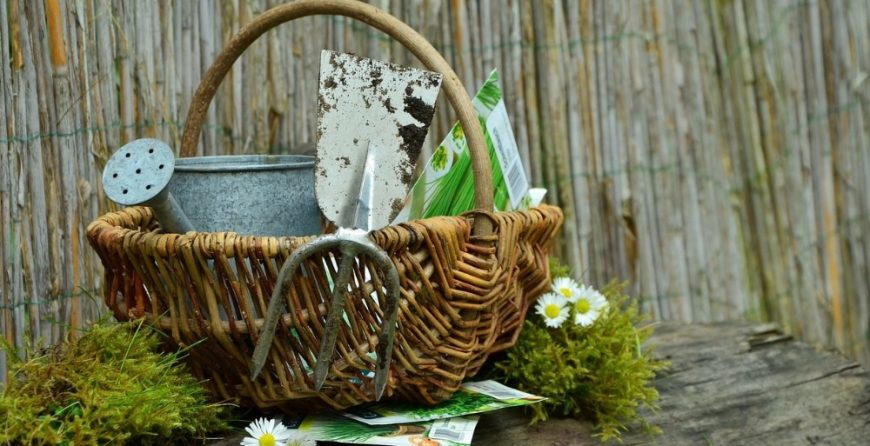Are you a first-time gardener?
We understand how easy it is to get excited when you are beginning your gardening journey. This means getting overboard in buying gardening tools, even if it costs you a lot of money. However, as a beginner, you must focus on the basics to prevent your storage from being overcrowded.
So what do you need to purchase to start with your new hobby? Here are 12 important tools you may choose from.
1.GLOVES
While gardening can give you happiness, it can also give your hands thorns and splinters along the way. Gloves protect your hands not only from dirt but also from scratches.
How to choose the right gloves for your gardening needs?
- Gloves must be durable but not too heavy
- It must fit your hands perfectly to avoiding slipping off
- Must be waterproof but breathable for hands comfort
- Longer cuffs are better to avoid blister on wrists and forearms and also prevent the soil from getting inside the gloves.
2.PRUNING SHEARS
There are different pruning shears for different purposes. This includes:
Hand Pruners
This also called Secateurs. It is used for plants that are starting to get out of control thus attempting to take over your garden.
Anvil-Style Pruners
This is similar to a knife on board. It has sharp blades that meet in a flat surface. It is best used for dead woods.
Bypass Pruners
This is best for live plants and other green woods. It has sharp blades that pass a sharp-edge and flat surface, like scissors.
Some facts about pruners
- Pruners should easily fit in your palm.
- Ratcheting your pruners increase cutting strength.
- Sharpen your pruners regularly
3.LOPPER/s
Loppers are another type of cutting tool. It has long handles to trim hard to reach areas and thicker branches. It normally ranges between 16 to 36 inches long. Just like in pruners, keep the lopper’s blade sharpened regularly to maintain a good condition.
4.GARDEN FORK
Garden fork is an efficient and effective tool in turning the soil because it can dig deeper rather compared to a spade.
How?
- Forks with curves in the spine is a great help in picking up mulch and in turning composts, like a pitchfork
- Straight tine is more excellent in digging compacted, rocky and clay soil
- Square forks are more powerful than Flat Tines that can bend if they hit a rock or a root.
5.HAND TROWEL
This tool is essential in relocating bedding plants and herbs, planting containers, and even taking out weeds.
How to choose the perfect hand trowel for your needs?
Choose a trowel that is made from stainless steel for durability and longer use. Select one with a broad blade that allows you to move more soil. Ultimately, choose one with a handle that comfortably fits your hands for an easy grip.
6.SPADE
This tool is the workhorses of the garden. It helps in:
- Edging
- Digging holes for plants
- Moving small dirt in places
- Raising sod
These tools might be pricey but a good quality spade can last for a long time. Choose a spade made from stainless steel for durability and longer usage.
7.RAKE
A rake helps in easily whisking falling leaves and debris away. This comes in different styles and sizes. But you can start with a basic leaf rake as a beginner.
8.HOE
The type of your garden defines what type of hoe you need.
For example, a vegetable garden requires a sturdy and wide hoe. While if you have a perennial garden, a thinner and delicate hoe can be used. Hoes are handy in preparing beddings and cutting out weeds.
Weeding hoe a.k.a Hula/Stirrup with an open square head is best for cutting down to growth. Flat hoe is great in turning soils in a vegetable garden.
9.GARDEN HOSE with ADJUSTABLE SPOUT/NOZZLE
Water is important for your garden. That is why a garden hose that can reach and spray water in every area is a requirement. There are three basic diameters for hoses:
½ inch (gives an avg of 9 gallons per min.)
⅝ inch (gives an avg of 15 gallons per min.)
¾ inch (gives an avg of 25 gallons per min.)
Choose one with an adjustable spout/nozzle to give you control on the water pressure and the spray radius that you use.
10.WATERING WAND
You can give your plants a gentle shower by using a water-breaking wand. The watering wand’s extended reach helps in getting out of the way of containers, hanging plants, or at the back edges of the borders. However, do make sure to choose the appropriate length for your garden needs.
11.WATERING CAN
You have two choices for a watering can, plastic or metal. Consider these:
- Plastic cans are lighter but won’t last up long
- Metal watering cans should be galvanized to prevent rusting
- Take into consideration the size of the can in relation to your strength. How much can you lift?
- The handle must allow you to carry a can full of water
- Two-handled watering can give stability
What is your choice?
12.WHEELBARROW
Wheelbarrow helps you to haul heavy loads, move extra soils, or a pile of compost.
- Traditional barrow with dual-handles and a single wheel is harder to balance with a heavy or uneven load
- Single handle with two wheels barrow is easier to balance and is better for people with limited strength and can be pushed or pulled with one hand
Make sure to store your wheelbarrow clean and dry to avoid rust. Also, keep the wheels inflated for better wheeling.
Hope this list gave you the ideas you need in starting your garden project. As an additional tool for your garden, consider buying organic biomarkers to properly label your plants. Add one to your shopping cart, today.


